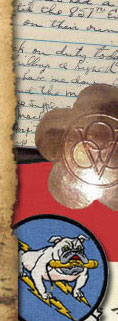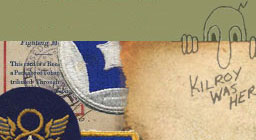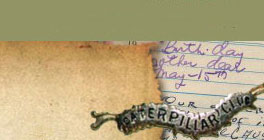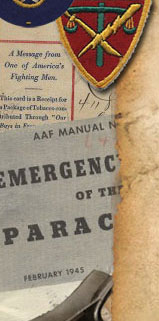

P-38 Lightning
Pilot Captain Charles P. Sullivan, Eureka, IL
Crashed September 20, 1943 (survived).
One of sixteen 39th FS P-38s that took off from 14-Mile Drome to escort B-24s on a mission against Wewak. Sullivan was leading a four-plane flight. South of the target at 24,000', Sullivan experienced engine trouble and was about to abort. Turning back for base, his engine returned to normal, and rejoined the squadron, but spotted an enemy fighter behind him that opened fire.
Charles Sullivan recalls:
"I looked into my rearview mirror and saw an unmistakable image: that of a Japanese fighter in firing position. He was so close I didn't bother to look over my shoulder and I didn't have time to be afraid!
Instinctively, I shoved the P-38 into a violent dive, dropping my auxiliary gasoline tanks as I went. It was then that I felt the shudder of bullets striking my plane. He had bit my left engine, which began spraying oil that started a smoky fire. I raced for the clouds below at speeds of nearly 500 miles per hour. The plane shuddered and shook from the strain. I looked back. I was pulling away from the Japanese fighter, but he was still stalking me. Oil began to spray on my windshield, obscuring my vision. I thought about parachuting right then, but instead I cut off the flaming engine and feathered the propeller, which stopped the fan and turned the blades so they would cut through the air with minimum drag. The fire in the left engine went out and my windshield cleared - but the stalker was still with me."
Sullivan managed to escape into a cloud, but flying on only one engine, and the stalking fighter disappeared. Without the left engine and its generator, he was without radio to report he was headed back to base. Experienceing problems with his right engine, he made a force landing around noon, sustaining a cut to his scalp, and spent the rest of the day cutting a path to trees nearby and spent the night there.
EscapeThe crash was the start of a harrowing thirty day ordeal. On the third day, he decided to leave the crash site and attempt to make his way back to base. After several days, and even spotting a friendly plane that he was unable to signal, he finally located native people. After an altercation in a village where he shot two villagers, he evaded natives for two weeks until locating an Australian Army patrol. Departing with a liason pilot aboard an observation plane, it sufferred engine problems, force landed and flipped over in the landing. Unhurt, the the following day, a C-47 picked him up at Dumpu Airfield, and returned to base at Port Moresby on October 20, 1943 a month after his force landing.
WreckageMax Ammer was the first outside to re-locate the crash site near village of Brahman. The wreck is in a swamp area for half the year, and is filled with mud and sediment. Only during the dry season is the wreck possible to reach. Since then, several other visitors have treked to the crash site.
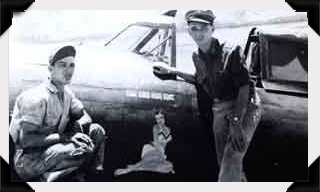
P-47D-4-RA Thunderbolt
Pilot 1st Lt. Marion C. Lutes, (MIA/KIA) Oklahoma
MIA April 29, 1944.
Flown by Lt. James W. Harris III of the 49th Fighter Group at Gusap Airfield, the aircraft had 71 on the nose and tail, also a girl on the side of the cockpit (painted by crew chief), and the pilot's name, 'J. W. Harris', with four Japanese victory flags. Lower on the cockpit was 'Crew Chief T/Sgt W. E. White' and 'Asst Cpl Screws'. The aircraft had a whiter vertical stripe outlined in red behind the cockpit, and red-lined US Star on the fuselage, and 'Star and bar' on the wing.
When the 49th FG converted to P-38 Lightnings, this aircraft was transferred to the 5th Service Group at Nadzab Airfield to be used as a training aircraft, by the Combat Replacement Training Center (CRTC School) Mission History Pilot Lutes took off at 14:15 from Nadzab #3 Airfield (Fighter Strip) to test fly this P-47 and test fire its guns in the Faita area. No contact was made after take off. In fact, he crashed in the Finisterre Mountains. It is unclear if Lutes bailed out, survived the crash, or died near the wreck. He is listed as Missing IN Action (MIA) to this day.
WreckageThe wreckage was first located at at about 8,200' near the villages of Nando and Tauta by a group of students 'Operation Drake' in 1979. They discovered the cockpit closed, and no remains were seen.

Swamp Ghost
On Feb. 23, 1942, a B-17E Flying Fortress bomber crashed in one of the most remote and wild places on Earth: the primitive Agaimbo swamp located on the island of Papua New Guinea. The plane, piloted by young U.S. Army Air Corps Capt. Fred Eaton, had flown a long, dangerous mission from Australia against the Japanese Fortress at Rabaul in New Britain. This was the first long-range Allied bombing mission of World War II following Japan’s attack on Pearl Harbor that included the U.S. The crew survived their ordeal and, after a six week trek to safety, returned to combat. Their B-17E, however, remained forgotten in the swamp until it was rediscovered in 1972 by an Australian Air Force crew.
In the mid-1980s, the late World War II pilot, restaurant industry pioneer and antique aircraft collector David Tallichet initiated efforts to recover and return the plane to U.S. soil. His dream was fulfilled in 2010 through the joint efforts of his family and aircraft salvage enthusiast Alfred Hagen.
Nicknamed Swamp Ghost, the B-17E has become an icon of military aviation. In tribute to its intact state, romantic isolation and the extreme challenges involved in its salvage, it is known among historians as military aviation’s Holy Grail.
Coincidentally, the B-17E was assigned to the Kangaroo Squadron, which flew into Pearl Harbor from San Francisco during the Japanese attack on December 7, 1941. This occurrence contributed to the disaster because U.S. Oahu radar personnel assumed the incoming Japanese attack wave represented the squadron’s expected arrival. Swamp Ghost was not with the squadron on that fateful day, but flew in shortly after the attack.
Prior to its salvage, Swamp Ghost was considered the best-preserved unrecovered B-17E in the world. With its return to the Port of Long Beach, Swamp Ghost completed its final mission 68 years after take-off. Only four aircraft models of its type have ever been recovered. The aircraft will be restored, possibly to flying condition, for display at an aviation museum as a symbol of America’s military aviation heritage.
Read More About Swamp Ghost
>>The Last Flight of Swamp Ghost
>>Boeing B-17 Flying Fortress Fast Facts
>>About Swamp Ghost Salvage Team
